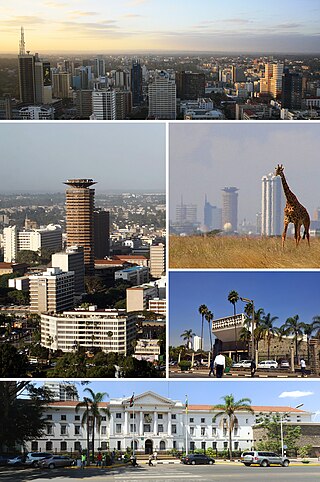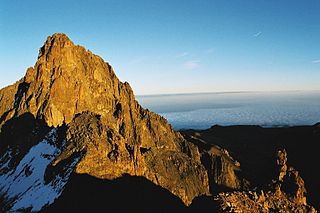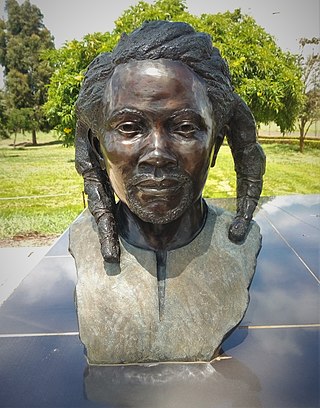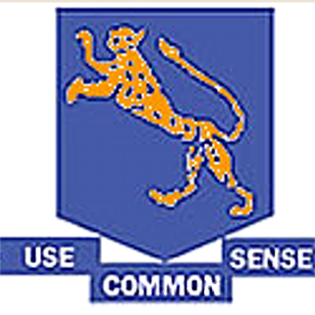
Nairobi is the capital and largest city of Kenya. The name is derived from the Maasai phrase Enkare Nairobi, which translates to 'place of cool waters', a reference to the Nairobi River which flows through the city. The city proper had a population of 4,397,073 in the 2019 census. The city is commonly referred to as The Green City in the Sun.

Mount Kenya is an extinct stratovolcano in Kenya and the second-highest peak in Africa, after Kilimanjaro. The highest peaks of the mountain are Batian, Nelion and Point Lenana. Mount Kenya is located in the former Eastern and Central provinces of Kenya; its peak is now the intersection of Meru, Embu, Kirinyaga, Nyeri and Tharaka Nithi counties, about 16.5 kilometres south of the equator, around 150 km (90 mi) north-northeast of the capital Nairobi. Mount Kenya is the source of the name of the Republic of Kenya.

Eldoret is the fifth largest city in Kenya. It is located in the Rift Valley region and serves as the capital of Uasin Gishu County. The town was referred to by white settlers as Farm 64 and colloquially by locals as 'Sisibo'. As per the 2019 Kenya Population and Housing Census, Eldoret is the fifth most populated urban area in the country after Nairobi, Mombasa, Nakuru and Ruiru. Lying south of the Cherangani Hills, the local elevation varies from about 2,100 metres (6,900 ft) at the airport to more than 2,700 metres (8,900 ft) in nearby areas. The population was 289,380 in the 2009 Census, and it is currently the fastest growing town in Kenya with 475,716 people according to 2019 National Census. Eldoret was on course to be named Kenya's fourth city, but was edged out by Nakuru in 2021.

The White Rose of York is a white heraldic rose which was adopted in the 14th century as a heraldic badge of the royal House of York. In modern times, it is used more broadly as a symbol of Yorkshire.

Dedan Kimathi Waciuri, born Kimathi wa Waciuri in what was then British Kenya, was the senior military and spiritual leader of the Mau Mau Uprising. Widely regarded as a revolutionary leader, he led the armed military struggle against the British colonial regime in Kenya in the 1950s until his capture in 1956 and execution in 1957. Kimathi is credited with leading efforts to create formal military structures within the Mau Mau, and convening a war council in 1953. He, along with Baimungi M'marete, Musa Mwariama, General China and Muthoni Kirima, was one of the Field Marshals.
Education in Kenya refers to the education system in Kenya. It is considered a basic right that should be offered to every individual. Education in Kenya predates to as early as the 18th century among the Swahili people. The earliest school was established by missionaries in Rabai. During the colonial era, the number of Kenyans with exposure to education steadily increased and a good number of them were privileged to proceed abroad for further education.

Friends School Kamusinga (FSK), popularly known as Kamu/Frishka, is a Kenyan Quaker national school established in 1956 and located in Kimilili, Bungoma County, Kenya. The school is located 409.9 kilometres from Kenya's capital city, Nairobi. It is annually ranked among the top schools nationwide in KCSE and has many notable alumni across business, creative arts, sports, engineering and politics.

The Kenya national rugby union team, commonly known as the Simbas, is the country's national team managed by the Kenya Rugby Union. The team plays in red, green, and black jerseys with black or white shorts. The Simbas represent Kenya in the Africa Cup and various other tournaments across the continent. They currently rank thirty-third in the World Rugby Rankings and fourth in Africa. Kenya is yet to qualify for the Rugby World Cup.

The Nairobi School is a secondary school in Nairobi, Kenya. It follows the national curriculum, is one of Kenya's 112 national schools and also one of the 18 prestigious Cluster III secondary schools.
Philip Leakey is a former Kenyan politician. He was the first White member of the Kenyan Parliament since independence.
Strathmore School is Kenya's first multi-racial school, established in 1961 in the Lavington area of Nairobi. It began as a residential Sixth Form College offering British-styled A-level courses and in 1963 switched from the Cambridge School Certificate Examination to the London GCE. In 1977 it became a full-fledged Secondary school. In 1988, the school began offering education under the KCSE - Kenya Certificate of Secondary Education - curricula which it follows to date. The first batch of Primary school students entered in 1987. It no longer has any boarders.
Mang'u High School is a Kenyan Roman Catholic National High School established in 1925, located in Kiambu County along the Nairobi-Thika Highway six kilometres (3.7 mi) from Thika, Kenya. Mang'u High School is ranked among the top schools nationwide in Kenya Certificate of Secondary Education and has many eminent alumni including one Kenyan president, several vice presidents, Central Bank of Kenya governor and a former Cardinal.
Harrison College is a co-educational grammar school in Bridgetown, Barbados. Founded in 1733, the school takes its name from Thomas Harrison, a Bridgetown merchant, who intended it to serve as "A Public and Free School for the poor and indigent boys of the parish".
Dagoretti is an area in the western part of Nairobi, the capital of Kenya. It straddles the Nairobi and Kiambu County boundary with the Dagoretti Road Reserve marking the psychological border point heading Northerly and North-Easterly. Administratively it is one of eight divisions of Nairobi. The Dagoretti division is divided into six Locations. The former electoral Dagoretti Constituency had the same boundaries as the now defuct Dagoretti division.
The Kenya High School is a public girls' high school located on Mandera Road in the upmarket Kileleshwa Ward and suburb of Dagoretti North Sub-County in Kenya's capital city, Nairobi.

Maseno School, located in Kisumu County in Kenya, is one of the oldest formal education schools in the country.
The Eric Shirley Shield is a rugby union tournament in the Kenyan domestic league. It was founded in 1962 as a second tier competition to the Nairobi District Championship
The Kimilili School is an international, private, boys' high school located in Kimilili, near Bungoma in Kenya's Western Province. It was known as Kimilili School until January 2009.
The Kenya Navy Band is the sole musical unit in the Kenya Navy and one of three state-sponsored military bands in the Kenya Defence Forces.
The Masai Agreement of 1904 was a treaty signed between the British East Africa Protectorate government and leaders of the Maasai tribe between 10 and 15 August 1904. It is often wrongly called the Anglo-Maasai Agreement, but that was not its proper name. The Maasai tribe agreed to cede possession of pastures in the Central Rift Valley Rift Valley in return for exclusive rights to two territories, a southern reserve in Kajiado and a northern reserve in Laikipia.
















